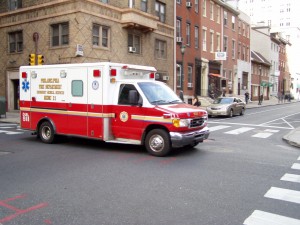
The school of public health at Drexel University is currently analyzing data to study the little-known and often unexpected phenomenon of Philadelphia first responders getting assaulted by the victims they are trying to help. The data is based on reports from the Philadelphia Fire Department. While it is an expected aspect of a paramedic’s job to operate in violent situations, the violence isn’t usually expected to occur between the paramedics and the patients they are trying to treat.
One thing to note is that it’s a felony to assault a first responder in Pennsylvania.
While the number of such incidents is relatively few, being reported to be around less than 20 per year, associate professor Jennifer Taylor explained that this particular type of assault is often underreported. It was discovered that female paramedics are more frequently assaulted than male responders.
However, Taylor suggested that this might be misleading, since women are more likely to go into this profession and are therefore more involved in calls that could potentially put them in danger.
Additionally, though as paramedics men and women share the same risk, men are less likely to report the incidents because of the “macho” nature of the job coupled with the male psyche.
That is what city Fire Commissioner Derrick Sawyer told NBC Philadelphia as well. “From the male perspective, I can see the [incidents being] underreported because of the ‘macho’ nature of the fire service,” he said. “Sometimes they are not reported because they’ve gotten the patient under control so they feel there’s no reason to report the assault.”
When asked about the reasons of this assault, Taylor provided several theories to help make sense of the situation.
The patients are under a lot of stress. The patients are often either in a state of extreme panic or under the influence of drugs that alter their mental state; when confronted by these responders, they respond in an aggressive manner, which is, to a certain extent, justified by the context of the situation. Therefore, it is extremely challenging during an investigation to determine if the assault was intended or not.
Taylor emphasized the importance of stress and how it factors into the situation. The nature of a paramedic’s job is very hectic, often with one call after another. In Philadelphia, the number of calls per day is extremely high. Therefore, these paramedics are often stressed out, both physically and psychologically.
She emphasized that while most are trained to be physically resilient, they are far less prepared to cope with the psychological stresses of the job. Paramedics and first responders deal with mostly impoverished people and such prolonged exposure to these difficult environments has a significant psychological toll. These responders often see a lot, but are very limited in terms of what they can do to help, which leaves them in a helpless state, allowing for feelings of guilt to foster.
Overall, it’s important to understand that paramedics do not start their job expecting to be assaulted. In fact, it is something that they internalize over time. Especially when analyzing phenomena like this, Taylor emphasizes the importance of acquiring qualitative over quantitative data.
Since quantitative data only answers how much, it isn’t very helpful in understanding the why, something that is extremely important to social issues. Hence part of the research involved interviewing first responders in focus groups. The biggest and most concerning discovery from these sessions was the realization that the psychological aftermath of these incidents often makes the job undesirable for the medics. Currently there is no particular module or training in paramedics’ schooling to help prepare the responders for potential combative experiences with patients. While the responders do prepare for physical confrontation by using body armor and Mace, there is no precedent to help deal with the psychological issues, something that hospitals handle better than mobilized medical services.
Ultimately, the goal of this research is to inform the public about this situation, start a conversation and take measures to improve the conditions and resources available to these paramedics and first responders who, according to NBC 10, make about 340,000 runs annually.

